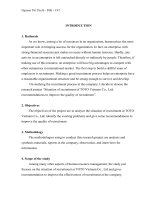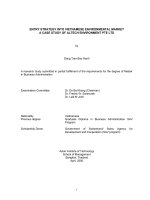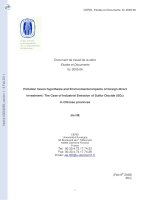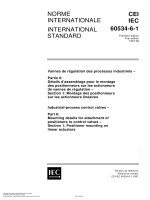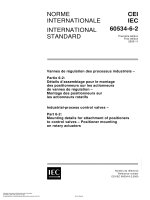Industrial attachment of Sadma fashion wear ltd
Bạn đang xem bản rút gọn của tài liệu. Xem và tải ngay bản đầy đủ của tài liệu tại đây (2.68 MB, 86 trang )
Sadma
Industrial Training Report
adma Fashion Wear Ltd.
1 | P a g e
Southeast University
S
INDUSTRIAL TRAINING
Course Code: Tex
-4036
INDUSTRIAL ATTACHMENT OF
Sadma Fashion Wear Ltd.
Sadma
Industrial Training Report
adma Fashion Wear Ltd.
2 | P a g e
Southeast University
CHAPTER ONE
Company Profile
Sadma
Industrial Training Report
adma Fashion Wear Ltd.
3 | P a g e
Southeast University
S
1.1. Company Profile at a glance
1.
Factory
: Sadma Fashion Wear Ltd.
2.
Factory Address
: Mouchak, Kaliakoir, Gazipur, Bangladesh.
Phone: 88-02-9298027-8, 88-02-9298048.
3.
Head Office
: Oriental Plaza, house # 3, Flat # B1, Road # 4,
Block # F, Banani, Dhaka, Bangladesh.
Phone : 88-02-8834825, 88-02-9871911,
Fax # 88-02-9870502
/
4.
Chairman
: Md. Lokman Hossain
Mobile : 01713-038619,01713-245582
5.
Managing Director
: Md. Nasir Uddin Mobile : 01713-245588
/
6.
Director
: Jahir Uddin Mamun
Mobile : 01713-085117
/
7.
Contact Person
: 1. Md. Al-Amin
General Manager, Garments
Mobile : 01713-245585
/
2. Roushan Zamir Rony
General Manager, Dyeing
Mobile : 01912-201117 , 01713-245593
,
3. Md. Masudur Rahman
General Manager, Knitting
Mobile : 01711676758
Sadma
Industrial Training Report
adma Fashion Wear Ltd.
4 | P a g e
Southeast University
S
8. Year of Establishment : 07.01.2002
9. Paid Up Capital : 40, 000, 00. 00
10. EPB Registration : 4224
11. Bank : SOCIAL ISLAMI BANK LIMITED.
Foreign Exchange Branch,
Motijheel C/A, Dhaka, Bangladesh.
TEL: 9571254 FAX: 9571100
Factory A/C NO: 13300009963
Bank Swift No: SOIVBDDHFEX
12. Product Mix : Single jersey plain fabric, Pique, Single lacoste, 1x1 rib,
2x2 rib, Plain interlock
13. Main Product : T-shirt, Polo shirt and different types of Men’s, Lady’s
& Kid’s wear in varies kinds of knit fabric.
1.2. Office Staff
A large team of Technical personnel are directly working, assisting the workers &
Coordinating pattern, cutting, sewing, quality & finishing-packing. About 200 people are
working as a Supervisor, Line chief, Floor in-charge, Section Manager.
1.3. Quality Policy
Sadma Fashion Wear Ltd. is totally committed to provide quality products that always
meet the needs and expectations of customers for reliability, safety, and economy and on-
time delivery of shipments. To achieve this objective, Sadma Fashion Wear Ltd. provides
all the necessary resources to ensure a well-equipped and adequately trained, and
experienced manpower to take proper care of customer requirements. Sadma Fashion
Wear Ltd. Emphasized that quality is the shared responsibility of its entire staff. The
Sadma
Industrial Training Report
adma Fashion Wear Ltd.
5 | P a g e
Southeast University
S
company ensures that all personnel are familiar with, and work to the company’s work
practices as well in conformity with the legal and other obligatory requirements and are
determined to comply with the requirements of Buyer’s expectation e.g. code of conduct,
social compliance and continually improve its production and Quality Assurance
Department. To manufacture quality products and Customer satisfaction is the company’s
goal.
1.4. Welfare Facilities
Induction of workers welfare committee aimed at improving workers morale,
job satisfaction & attendance.
Canteen facilities.
Subsidized lunch for staff.
Free snacks for workers.
Full time free of medical service provide by a professional doctor.
Provision for day care center for workers children, annual picnic.
Cultural function.
Each floor has sufficient number of washroom.
Each floor has sufficient lighting to facilitate production.
A large dining hall is in the factory including pure drinking water & well sitting
arrangement.
Maternity leave & benefit for female workers are provided as per labor law.
1.5. Compliance
Factory are obeying and maintaining international and local law’s, Human rights, Social
compliance, Labor law and other rules and instruction by related department of
Government.
1.6. Recruitment policy
No child labor in this factory.
No gender discrimination in recruitment procedure.
There is no force labor.
Sadma
Industrial Training Report
adma Fashion Wear Ltd.
6 | P a g e
Southeast University
S
1.7. Different Departments
Knitting
Dyeing
Finishing
Garments
Utility
Maintenance
Quality Assurance
Planning
Research & Development
Admin
HR & Compliance
1.8. Present Buyers
C & A (Germany)
Zellers (Canada)
George (U.K)
Sears (Canada)
Sainsbury (U.K)
Diplomat Fashion (U.S.A)
Matalan (U.K)
Artextyl (U.S.A / France)
S F G (Australia)
Xios (U.S.A)
Vayla (U.S.A)
Walmart (U.S.A)
Emporio Junior(Italy)
Pierre Cardin (Italy)
Carrefour Import Sas (France)
Sadma
Industrial Training Report
adma Fashion Wear Ltd.
S
Primeasia University 6 | P a g e
Sadma
Industrial Training Report
adma Fashion Wear Ltd.
7 | P a g e
Primeasia University
S
1.9. Certification
ISO 9001:2008, WRAP.
Member: Bangladesh Garments Manufactures & Exporters Association (BGMEA)
Sadma
Industrial Training Report
adma Fashion Wear Ltd.
8 | P a g e
Primeasia University
S
1.10. Production Capacity
Production Capacity Knitting : 12000 Kgs Per Day
Production Capacity Dyeing & Finishing : 8000 Kgs Per Day
Production Capacity Garments : 20000 Pcs. Per Day
Production lead time : 45-90 Days
1.11.
Production Area
Knitting space
: 5000 sq. feet
Dyeing space
: 34000 sq. feet
Finishing Goods & Store
: 5500 sq. feet
2nd Floor
: 5500 sq. feet
3rd Floor
: 6500 sq. feet
4th Floor
: 6500 sq. feet
5th Floor
: 6500 sq. feet
6th Floor
: 6500 sq. feet
Other space
Total space
: 2000 sq. feet
: 77000 sq. feet
Sadma
Industrial Training Report
adma Fashion Wear Ltd.
9 | P a g e
Primeasia University
S
1.12. Man power Management
Organogram of Knitting section
General Manager
Production Manager
Store In charge
Supervisor
Quality In charge
Operator
Helper
Sadma
Industrial Training Report
adma Fashion Wear Ltd.
10 | P a g e
Primeasia University
S
Organogram of Dyeing & Finishing section
GM
DGM
PM
SPO
Batch In
ccharge
Finishing In
charge
Lab In
charge
PO
APO
Supervisor
Sewing man
Turning m/c
Operator
Sewing man
Squeeze
Operator
Lab
Technician
Q.C.
Technician
Operator
Helper
Dryer
Operator
Helper
Helper
Compactor
Operator
Sadma
Industrial Training Report
adma Fashion Wear Ltd.
11 | P a g e
Primeasia University
S
Factory Building
Sadma
Industrial Training Report
adma Fashion Wear Ltd.
12 | P a g e
Primeasia University
S
CHAPTER TWO
Knitting Section
Sadma
Industrial Training Report
adma Fashion Wear Ltd.
13 | P a g e
Primeasia University
S
2.1. Process Definition
Knitting is a method by which thread or yarn may be turned into cloth or other fine crafts.
Knitting consists of consecutive loops, called stitch. As each row progresses, a new loop is
pulled through an existing loop. The active stitches are held on a needle until another loop can be
passed through them. This process eventually results in final product, often a garment.
2.2. Raw Materials for Knitting
1. Yarn
2. Lycra
2.3. Source of Raw Material
- Saiham cotton mills ltd.
- Shamsuddin spinning
- Matam spinning
- A T &T spinning
- N.Z. spinning
- PHP spinning
- Zubayer spinning
- Square Yarns ltd.
- Maksons spinning
- Rising spinning
- Anwar Mannan Textile
- J.K. spinning
- The Delta spinning
- R.K. spinning
- Jamuna spinning
- Shiria spinning
- Tara spinning
- Karim spinning
- Paradise spinning
- Out pace spinning
- Silver line composite
- GPI Textiles, India
- BKM, Indonesia
- Hysoung, Vietnum etc.
Sadma
Industrial Training Report
adma Fashion Wear Ltd.
14 | P a g e
Primeasia University
S
2.4. Classification of Knitting section
Knitting section is divided into two parts-
1. Circular knitting section.
2. Fabric inspection section.
2.4.1. Circular Knitting section
There are two types of machines available in this area-
1. Single jersey and
2. Double jersey.
2.4.2. Machine description of circular Knitting section
SL. No.
Machine
Brand
Origin
Machine
Diameter
Gauge
Feeder
Quantity
1
S/J
Runshan
China
20”
24
60
3 set
2
S/J
Runshan
China
22”
24
66
2 set
3
S/J
Runshan
China
18”
24
54
2 set
4
S/J
Runshan
Chine
19”
24
57
2 set
5
S/J
Runshan
Chine
21”
24
63
2 set
6
D/J
Fukahama
Taiwan
40”
18
84
1 set
7
S/J
Fukahama
Taiwan
26”
24
78
1 set
8
S/J
Zentex
Singapore
30”
24
90
1 set
9
S/J
Fukahama
Taiwan
32”
24
96
1 set
10
S/J
Fukahama
Taiwan
24”
24
72
1 set
11
S/J
Masa
Taiwan
34”
20
102
1 set
12
S/J
Masa
Taiwan
32”
20
96
1 set
13
S/J
Lisky
Taiwan
21”
24
63
1 set
14
S/J
Lisky
Taiwan
25”
24
75
1 set
15
S/J
Lisky
Taiwan
19”
24
57
1 set
16
S/J
Masa
Taiwan
38”
24
114
1 set
17
S/J
Masa
Taiwan
36”
20
108
1 set
18
S/J
Boshuo
China
40”
24
120
1 set
19
S/J
Boshuo
China
38”
24
114
1 set
20
D/J
Lisky
Taiwan
40”
24
84
1 set
21
S/J
Lisky
Taiwan
28”
24
84
1 set
22
S/J
Boshuo
China
36”
24
108
2 set
23
S/J
Boshuo
China
34”
24
102
2 set
24
S/J
Yong cheng
Taiwan
26”
24
78
2 set
25
S/J
Yong cheng
Taiwan
30”
24
90
2 set
26
S/J
Yong cheng
Taiwan
24”
24
72
2 set
27
S/J
Zentex
Singapore
20”
24
60
2 set
28
S/J
Bushuo
China
25”
24
74
1 set
Sadma
Industrial Training Report
adma Fashion Wear Ltd.
15 | P a g e
Primeasia University
S
2.5. Fabric Inspection section
There is one machine in cloth inspection section. Specification of this machine is given
below:
Machine name
Perfect fabric check machine
Manufacturer
Seven Star Engineering
Country
Bangladesh
Year of manufacturing
2008
2.6. Production Process
2.6.1. Process Flow chart of Knitting in Sadma
Sample fabric
Design analysis
Machine selection
Setting the machine for the specific design
Yarn in cone form
Feeding the yarn cone in the creel
Feeding the yarn in the feeder via trip-tape positive feeding arrangement and tension devices
Knitting
Sadma
Industrial Training Report
adma Fashion Wear Ltd.
16 | P a g e
Primeasia University
S
Withdraw the rolled fabric and weighting
Inspection
Numbering
2.6.2. Description of Production Process
In every mill, a sequence is maintained in production processing. It is also followed in this
mill. The process sequences are in list below:
1) Firstly, knitting manager gets a production shit from the merchandiser as accordance as
consumer requirements then he informs or orders production officer about it.
2) Production officer informs technical in charge and knows about machine in which the
production will be running.
3) Technical in charge calls for leader of mechanical fitter troops, they two take decision
about machine for production considering machine condition, production capacity,
maintenance complexity, etc.
4) Production officer with experienced mechanical fitter adjusts required stitch length and
grey GSM for required final GSM.
5) Supervisor checks daily production regularity and make operator conscious about
finishing task due time.
6) Operators operate machine in high attention as if there were no faults in the fabrics. If he
thinks or sure about any fabric fault, then he calls for the mechanical fitters in duty.
Mechanical fitter then fixes it if he can or he informs technical in charge. Then he comes in
spot.
7) After required production and final inspection in 4-point system, they sent in dyeing
section.
Sadma
Industrial Training Report
adma Fashion Wear Ltd.
17 | P a g e
Primeasia University
S
0
/
ourse /
C
o. o
PM
Cours
2.7. Production Parameter
1. Machine Diameter
2. Machine rpm (revolution per minute)
3. No. of feeds or feeders in use
4. Machine Gauge
5. Count of yarn
6. Required time (M/C running time)
7. Machine running efficiency
2.8. Relationship between Knitting Parameters
1. GSM increase with the increase of stitch length.
2. If stitch length increase then fabric width increase and WPI decrease.
3. If machine gauge increase then fabric width decrease.
4. If yarn count increase (courser) then fabric width increase.
5. If shrinkage increases then fabric width decrease but GSM and WPI increase.
6. For finer gauge, finer count yarn should use.
7. Grey GSM should be less than finish GSM.
2.9. Production Calculation
A. Production/shift in kg at 100% efficiency
RPM
No.
of Feeder No. of Needle
SL(mm)
3527.80 Yarn
count
B. Production/shift in meter
Course / min .
R
C. Fabric width in meter
e cm
N
f Feeder
60
8
cm 1
0
Efficiency
Total no. of wales
Wales / cm 100
Total no. of Needles used in k nitting
Wales / cm 100
Sadma
Industrial Training Report
adma Fashion Wear Ltd.
18 | P a g e
Primeasia University
S
2.10. Considerable Points to produce knitted fabric
When buyers order for fabric then they mention some points related to production and quality.
Before production of knitted fabric, these factors are needed to consider. These includes-
- Type of Fabric or design of Fabric.
- Finished G.S.M.
- Yarn count.
- Types of yarn (combed or carded).
- Diameter of the fabric.
- Stitch length.
- Color depth.
2.11. G S M
It is a technical term that indicates the weight of the fabric per square meter.
Points considered while setting grey GSM:
- Level
- Enzyme Color
- Suited or non- suited
Changing of GSM:
- Major control by VDQ pulley.
- Minor control by stitch length adjustment.
- Altering the position of the tension pulley changes the G.S.M. of the fabric. If pulley
moves towards the positive direction then the G.S.M. will decrease. And in the reverse
direction G.S.M will increase.
2.12. Factors should change in case of Fabric Design
- Cam setting
- Set of needle
- Size of loop shape
2.13. Effect of Stitch length on color depth
If the depth of color of the fabric is high loop length should be higher because in case of fabric
with higher loop length is less compact. In dark shade dye take up% is high so GSM is adjusted
then. Similarly in case of light shade loop length should be relatively smaller.
Sadma
Industrial Training Report
adma Fashion Wear Ltd.
19 | P a g e
Primeasia University
S
2.14. Responsibilities of a Production Officer
Monitor and control shift wise production, plant utilization, waste generation etc.
implement correct work methods and maintain all records related to production.
Responsible for systematic planning and execution of production programs.
Adequate control over process in order to achieve quality of product & better waste
management.
Monitor shift wise production, utilization etc. and take corrective action for any shortfall.
Maintain all the procedure of his department and shall incorporate amendments as and
when required in procedure.
Responsibilities for monitoring the performance of manpower under him and
identification of training needs.
2.15. Methods of Increasing Production
By the following methods the production of knitted fabric can be increased –
1. By increasing m/c speed: Higher the m/c speed faster the movement of needle and ultimately
production will be increased. But it has to make sure that excess tension is not imposed on yarn
because of this high speed.
2. By increasing the number of feeder: If the number of feeder is increased in the
circumference of cylinder, then the number of courses will be increased in one revolution at a
time.
3. By using machine of higher gauge: The more the machine gauge, the more the production .
So by using machine of higher gauge production can be increased.
4. By imposing automation in the m/c: a) Quick starting & stopping for efficient driving
system. b) Automatic m/c lubrication system for smoother operation. c) Photo electric fabric
fault detector.
5. By imposing other developments: a) Using creel-feeding system. b) Applying yarn supply
through plastic tube that eliminates the possibilities of yarn damage. C) Using yarn feed control
device.
2.16. Faults and Their Causes in Knitting
1. Hole
Causes:
Sadma
Industrial Training Report
adma Fashion Wear Ltd.
20 | P a g e
Primeasia University
S
• Holes are the results of yarn breakage or yarn cracks.
• During loop formation the yarn breaks in the rejoin of the needle hook.
• If the yarn count is not correct on regarding structure, gauge, course and density.
• Badly knot or splicing.
• Yarn feeder badly set.
Remedies:
• Yarn strength must be sufficient to withstand the stretch as well as uniform.
• Use proper count of yarn.
• Correctly set of yarn feeder.
• Knot should be given properly.
2. Needle Mark
Causes:
• When a needle breaks down then needle mark comes along the fabrics.
• If a needle or needle hook is slightly bends then needle mark comes on the fabrics.
Remedies:
• Needle should be straight as well as from broken latch.
3. Sinker Mark
Causes:
• When sinker corrode due to abrasion then some times can not hold a new loop as a result sinker
mark comes.
• If sinker head bend then sinker mark comes.
Remedies:
• Sinker should be changed
4. Star
Causes:
Sadma
Industrial Training Report
adma Fashion Wear Ltd.
21 | P a g e
Primeasia University
S
• Yarn tension variation during production.
• Buckling of the needle latch.
• Low G.S.M fabric production.
Remedies:
• Maintain same Yarn tension during production.
• Use good conditioned needles.
5. Drop Stitches
Causes:
• Defective needle.
• If yarn is not properly fed during loop formation i.e. not properly laid on to the needle hook.
• Take-down mechanism too loose.
• Insufficient yarn tension.
• Badly set yarn feeder.
Remedies:
• Needle should be straight & well.
• Proper feeding of yarn during loop formation.
• Correct take up of the fabric & correct fabric tension.
• Yarn tension should be properly.
6. Oil stain
Causes:
• When oil lick through the needle trick then it pass on the fabrics and make a line.
Remedies:
• Ensure that oil does not pass on the fabrics.
• Well maintenance as well as proper oiling.
Sadma
Industrial Training Report
adma Fashion Wear Ltd.
22 | P a g e
Primeasia University
S
7. Rust stain
Causes:
• If any rust on the machine parts.
Remedies:
• If any rust on the machine parts then fix it.
• Proper maintenance as well as proper oiling.
8. Pin hole
Causes:
• Due to break down or bend of the latch, pin hole may come in the fabric.
Remedies:
• Change the needle.
9. Cloth fall- out
Causes:
• Cloth fall- out can occur after a drop stitch especially when an empty needle with an empty
needle with closed latch runs into the yarn feeder and remove the yarn out of the hook of the
following needles.
Remedies:
• Make sure all the latches of needle are closed with feeding yarn after a drop stitch.
10. Fly dust:
Causes:
• In knitting section too much lint is flying to and fro that are created from yarn due to low twist
as well as yarn friction. This lint may adhere or attaches to the fabric surface tightly during knit
fabric production.
Remedies:
• Blowing air for cleaning the different parts after a certain period of time.
• By cleaning the floor continuously.
Sadma
Industrial Training Report
adma Fashion Wear Ltd.
23 | P a g e
Primeasia University
S
• By using suction system for cleaning too much lint on the floor.
• Over all ensure that lint does not attach to the fabric.
11. Yarn contamination
Causes:
• If yarn contains foreign matters then it remains in the fabric even after finishing,
• If lot or count mixing occurs.
Remedies:
• By avoiding lot & count mixing.
• Fault less spinning.
12. Yarn Faults:
• Neps.
• Slubs.
• Yarn count variations.
• Thick/Thin place in yarn.
• Hairiness.
• Dead Fiber.
2.17. Fabric Inspection system
Before batching the fabric is required to check. In this section fabric is check out. In this industry
4-point system is used for inspection. By using this system-
The defects are identified in the roll and marked by red arrows
Individually the length of defect is measured and record
Then measure penalty point
2.18. Different Fabric GSM and Their Yarn Count
S/J without lycra –
Sadma
Industrial Training Report
adma Fashion Wear Ltd.
24 | P a g e
Primeasia University
S
Fabric G.S.M
Yarn Count
110 - 120
40s – 36 s
120 - 130
36s – 32s
130 - 140
32s – 28s
140 - 150
28s
150 - 160
26s
170 - 210
24s
Rib without lycra –
Fabric G.S.M
Yarn Count
180 - 190
36s – 32s
190 - 200
30s
200 - 215
28s
215 - 230
26s
230 - 250
24s
250 - 300
24s
Interlock without lycra –
Fabric G.S.M
Yarn Count
200 - 220
34s
220 - 230
32s
230 - 250
30s
250 - 300
26s
Lacoste without lycra –
Fabric G.S.M
Yarn Count
180 - 190
30s
190 - 210
28s
210 - 230
26s
230 – 250
26s
40D Lycra Rib –
